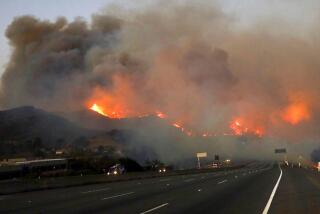Battalion Chief Cites Need for Fire Equipment and Stations
At a recent meeting in the San Fernando Valley, the vice president of the Los Angeles Fire Commission said responses to medical calls in hard-to-reach areas of the city were too slow to be of maximum benefit. He suggested charging fees in special assessment districts to generate revenue for the department to have sufficient resources to shorten those response times.
Battalion Chief Roger Gillis of the city Fire Department discussed the problems it faces when serving those areas and the concept of a special assessment district with Times correspondent Rebecca Bryant.
Question. A week or so ago, the vice president of the Fire Commission, David Fleming, said paramedic response time in some outlying areas of the city is too slow to be of maximum benefit in heart attack cases. How serious is the problem?
Answer. I think some of the key words were âof maximum benefit.â Thereâs no doubt that we would love to be able to provide quicker services throughout the city. The population has grown. The density in many areas has grown tremendously. The majority of our fire stations were built in the â50s and â60s for those times, and so we need obviously to have additional fire stations.
The mountainous areas have built up. The Santa Monica Mountains--those are areas where, obviously, locations of resources and topography are major contributing factors. In the Mulholland area and Mt. Washington, for example, the fire apparatus has to climb narrow, winding roads, steep terrain--they canât get the speeds up that we can on the major roads. Itâs probably going to take us longer to get into those areas.
On the average throughout the city for emergency medical service runs, for first responder, we average right about 4 1/2 minutes. Closer to five minutes for paramedic intervention. Five minutes is a standard goal for response time. Weâd like to meet that every time we get a call. Obviously we do not; we canât.
If I take a resource, especially in the outlying area, and I have them on an incident and it could be the stubbed-toe incident and now I have a heart attack call, that resource is tied up and now I have to go further away yet to bring a resource in and that of course increases response time into that area.
Of course the answer to that is more resources and more locations. And in some cases our stations need to be moved to a more central location within whatever district weâre talking about to provide a closer, quicker response time.
Q. In case of an emergency such as a heart attack, by what time must CPR be given before survival rates drop drastically?
A. We would use that four- to six-minute window. Our average response time is about 4 1/2 minutes. Thatâs to get a first responder on the scene and thatâs to get CPR started. One of the things weâve done in the last several years is training firefighters. Every firefighter is now (an) EMT, which means they can do CPR. We have now a defibrillator on every single company in the city of Los Angeles, which is markedly improved our heart attack success rate. The defibrillator is a machine that can monitor the person. It tells you exactly what their status is.
Q. If you had all the money in the world, how many more paramedics and firefighters would you have and where would they be?
A. Iâd put a paramedic on every corner in the city. Obviously thatâs the utopia.
The Fire Commission along with the people across the street at City Hall have asked us to look at that. There are studies under way to address that figure, to try to come up with an honest, hard figure. That we donât have yet.
The ballpark figure is that the chief has identified would be 700 to 1,000 more resources or employees; 99% of that would be firefighter/paramedic resources that would be put out in the field. That would be our goal, which would mean building new fire stations.
Proposition 13 reduced us by 450 personnel. We lost a person off every company and we never got them back. We want more personnel, more companies, but weâre not looking to go back to where we were prior to Proposition 13. Weâre not looking to build onto our individual firetrucks. We want more firetrucks, more fire stations, more facilities.
Q. Has the department determined where those new stations are needed?
A. That hasnât been determined, but theyâre developing a computerized program that would take our response times in any given area and tell us where we need to put resources to improve.
Q. It seems a special assessment district could create a dilemma: Well-off people would have to pay extra for what other people get in return for their taxes. At the same time, the less well-off might get poorer service because they canât afford to pay. Doesnât it make sense to tax everyone and give everyone the same level of service?
A. Yes. For us thatâs an easy one. The mayor, the council, anticipated a shortfall a couple of years ago and directed the department to look into ways of producing some more revenue.
Benefit assessment was one idea we came up with because Los Angeles County Fire Department had used it. The key ideas were benefit assessment, a subscription EMS program and charging for EMS treatment. The benefit assessment was strictly fire-oriented and was all-encompassing for the city.
It wasnât district-oriented. We donât feel thatâs a good idea. A hundred years ago across the country you paid for your fire protection. If you paid X amount of dollars, you put a little sign in front of your house that said you paid for fire protection. And if there was a fire, when the fire department rolled up, they looked for this little sign. If they rolled up and you didnât have your little marker and hadnât paid your dues, then they didnât fight the fire in your home.
Obviously thatâs not practical. Itâs not good sense. Itâs not L. A. City Fire Departmentâs way of doing business. If one district paid that assessment and the one next door did not, does that mean that district says, âYou canât use our resources over there?â We donât operate that way. We service everybody. Anytime weâre called, we go. There really are no boundary lines.
Q. Can you explain the difference between benefit assessment, which is what the county has, and a special assessment district for paramedic services in outlying areas?
A. The benefit assessment that the county has is all-encompassing. Special assessment, and Iâm not an expert, to me means youâve taken a specific district within your boundaries and if that area is willing to pay, that would be a district assessment.
And thatâs a term I know the commissioner used but isnât something we ever addressed, and we again donât feel thatâs the way to go. If weâre going to do it, we do it for all and we provide the service and the assessment and everybody takes part in it.
Theyâve never considered a special district assessment. I know that in talking with the chief, thatâs not something he feels would be a wise thing to do. I think weâd get into territorial battles and again the well-to-do could afford it. Those who canât, if you ask them for two more dollars, their budget is so tight two dollars would affect them. They wouldnât be able to do it, and they wouldnât vote for it because they couldnât afford to. I donât think itâs a good idea.
More to Read
Sign up for Essential California
The most important California stories and recommendations in your inbox every morning.
You may occasionally receive promotional content from the Los Angeles Times.










